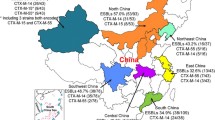Abstract
Extended spectrum beta-lactamase producing E. coli (ESBL-EC) are an emerging public health issue. In New Zealand (NZ), bla CTX-M-14 and bla CTX-M-15 are the most common ESBL genes. Although many studies describe risk factors for ESBL-EC, few describe risk factors for specific ESBL genes. Between January 2006 and December 2007, we characterized 108 consecutive, non-duplicate isolates of ESBL-EC at the Auckland Hospital laboratory. Demographic and clinical data were recorded. Of the 108, 54.6% (59) were CTX-M-15-EC, 26.9% (29) were CTX-M-14-EC and 12.09% were CTX-M-9 (13). The remaining seven isolates carried CTX-M-3 (3; 2.7%), CTX-M-65 (2; 1.8%), CTX-M-27 (1; 0.9%) and CTX-M-57 (1; 0.9%). CTX-M-15-EC were more likely than CTX-M-14-EC to be fluoroquinolone-resistant (86.4% versus 32.4%; p = 0.006) and to be non-susceptible to amoxicillin-clavulanate (84.7% versus 41.4%; p = 0.0001). Patients with CTX-M-15-EC were more likely to be of Indian ethnicity (34.5% versus 0%; p = 0.0012) and to have travelled recently (31.6% versus 4%; p = 0.0088). Patients with CTX-M-14-EC were more likely to have Chinese or South-East Asian ethnicity (48.1% versus 5.2%; p < 0.0001) and to have no history of either travel or prior hospital admission (44% versus 8.9%; p = 0.0006). These data imply that CTX-M-15 and CTX-M-14 producing E. coli are associated with distinct demographic subgroups in NZ.

Similar content being viewed by others
References
Cantón R, Coque TM (2006) The CTX-M β-lactamase pandemic. Curr Opin Microbiol 9:466–475
Heffernan H, Pope C, Carter P (2007) Identification of extended-spectrum β-lactamase types, plasmid mediated AmpC β-lactamases and strains among urinary Escherichia coli and Klebsiella in New Zealand in 2006. URL: http://www.surv.esr.cri.nz/PDF_surveillance/Antimicrobial/ESBL/ESBLIdentification_2006.pdf. Accessed 9 January 2012
Rossolini GM, D’Andrea MM, Mugnaioli C (2008) The spread of CTX-M-type extended-spectrum β-lactamases. Clin Microbiol Infect 14:33–41
Pitout JD, Gregson DB, Church DL et al (2005) Community-wide outbreaks of clonally related CTX-M-14 β-lactamase-producing Escherichia coli strains in the Calgary health region. J Clin Microbiol 43:2844–2849
Ben Ami R, Schwaber MJ, Nanon-Venezia S et al (2006) Influx of extended-spectrum β-lactamase-producing Enterobacteriaceae into the hospital. Clin Infect Dis 42:925–934
Calbo E, Romani V, Xercavins M et al (2006) Risk factors for community-onset urinary tract infections due to Escherichia coli harbouring extended-spectrum β-lactamases. J Antimicrob Chemother 57:780–783
Rodríguez-Baño J, Picón E, Gijón P et al (2010) Community-onset bacteremia due to extended-spectrum beta-lactamase-producing Escherichia coli: risk factors and prognosis. Clin Infect Dis 50(1):40–48
Clinical and Laboratory Standards Institute (2010) Performance standards for antimicrobial susceptibility testing; CLSI document M100-S20. Clinical and Laboratory Standards Institute, Wayne, PA
Jeong SH, Bae IK, Kwon SB et al (2005) Dissemination of transferable CTX-M-type extended-spectrum β-lactamase-producing Escherichia coli in Korea. J Appl Microbiol 98:921–927
De Gheldre Y, Avesani V, Berhin C, Delmee M, Glupczynski Y (2003) Evaluation of Oxoid combination discs for detection of extended-spectrum ß-lactamases. J Antimicrob Chemother 52:591–597
Tenover FC, Arbeit RD, Goering RV et al (1995) Interpreting chromosomal DNA restriction patterns produced by pulsed field gel electrophoresis: criteria for bacterial strain typing. J Clin Microbiol 33:2233–2239
Ensor V, Shahid M, Evans J, Hawkey P (2006) Occurrence, prevalence and genetic environment of CTX-M β-lactamases in Enterobacteriaceae from Indian hospitals. J Antimicrob Chemother 58:1260–1263
Chen YH, Hsueh PR, Badal RE et al (2011) Antimicrobial susceptibility profiles of aerobic and facultative Gram-negative bacilli isolated from patients with intra-abdominal infections in the Asia-Pacific region according to currently established susceptibility interpretive criteria. J Infect 62(4):280–291
Pitout JD, Campbell L, Church DL et al (2009) Molecular characteristics of travel-related extended-spectrum β-lactamase-producing Escherichia coli isolates from the Calgary health region. Antimicrob Agents Chemother 53:2539–2543
Manges AR, Tabor H, Tellis P, Vincent C, Tellier PP (2008) Endemic and epidemic lineages of Escherichia coli that cause urinary tract infections. Emerg Infect Dis 14:1575–1583
Acknowledgements
The authors would like to acknowledge Tracy Bathgate, Audrey Tiong, Sarah Baines and Rosemary Woodhouse for their help with this study.
Author information
Authors and Affiliations
Corresponding author
Rights and permissions
About this article
Cite this article
Freeman, J.T., Williamson, D.A., Heffernan, H. et al. Comparative epidemiology of CTX-M-14 and CTX-M-15 producing Escherichia coli: Association with distinct demographic groups in the community in New Zealand. Eur J Clin Microbiol Infect Dis 31, 2057–2060 (2012). https://doi.org/10.1007/s10096-011-1540-3
Received:
Accepted:
Published:
Issue Date:
DOI: https://doi.org/10.1007/s10096-011-1540-3



